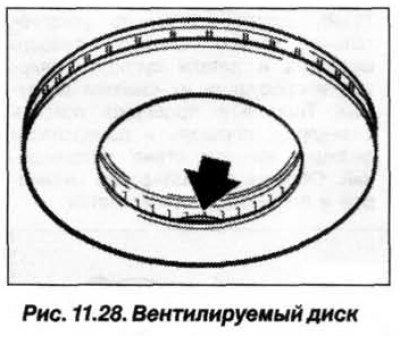
If you need to completely remove the caliper, then first - fix the pedal in a half-pressed state (see fig. 11.3), unscrew the brake hose from the brake pipe connector.

At the same time, keep the hose from twisting by the hexagon. Some loss of brake fluid may occur, which must be collected in a container, and the pipeline and hose must be plugged. At the rear caliper, additionally disconnect the handbrake cable. Loosen the fixing screw (arrow, fig. 11.27) 5 mm hex socket wrench.

Remove the brake disc using a universal puller and, if necessary, lightly tapping the base of the brake disc with a plastic mallet. If the removal of the brake disc is not possible without the use of large shock forces, then it is necessary to replace the brake disc and wheel bearing with new ones.
Attention! Brake discs are ground and replaced simultaneously at both ends of the axle.
Ventilated brake disc balanced by clamps (staples), installed on its inner diameter (arrow, fig. 11.28), which must remain strictly in their places. Irregularities on the mating plane of the disc and the hub can lead to warping of the brake disc.

The installation of the brake disc should be carried out in the reverse order, if necessary. Thoroughly clean the mating plane with the brake disc on the wheel hub, if necessary, remove traces of corrosion, after dissolving them.
Before installing the disc, clean its surface, remove the protective varnish from the new disc with a nitro thinner, check the condition of its surface and thickness. The maximum allowable runout of the installed disc on the braking surface must not exceed 0.2 mm.
Measure the thickness of the installed disc (see below) at the thinnest point and in various places. Install the brake disc on the wheel hub and tighten the fastening screw to a torque of 16 Nm (1.6 kgf·m).
Install caliper with new brake pads. Make sure the brake hose is not twisted or stretched. Turn the steering wheel to the right and to the left as far as it will go, observing the free movement of the brake hose.
Check the tightness of the brake hose fitting with a torque of 14.0 Nm (1.4 kgf·m). Fasten the caliper with lightly greased bolts, tightening them with a torque of 110 Nm (11.0 kgf·m). Install the front wheels according to the markings, tighten the mounting bolts by hand, lower the vehicle and tighten the mounting bolts crosswise to a torque of 140 Nm (14.0 kgf·m). Install wheel bolts dry.
Press the brake pedal strongly several times, until a pronounced resistance, while the brake pads will take up their working position.
Attention! If the brake hose was removed, then after installing it, bleed the brake system and restore the brake fluid level in the compensation tank.
